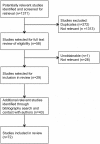The role of host genetics in susceptibility to influenza: a systematic review
- PMID: 22438897
- PMCID: PMC3305291
- DOI: 10.1371/journal.pone.0033180
The role of host genetics in susceptibility to influenza: a systematic review
Abstract
Background: The World Health Organization has identified studies of the role of host genetics on susceptibility to severe influenza as a priority. A systematic review was conducted to summarize the current state of evidence on the role of host genetics in susceptibility to influenza (PROSPERO registration number: CRD42011001380).
Methods and findings: PubMed, Web of Science, the Cochrane Library, and OpenSIGLE were searched using a pre-defined strategy for all entries up to the date of the search. Two reviewers independently screened the title and abstract of 1,371 unique articles, and 72 full text publications were selected for inclusion. Mouse models clearly demonstrate that host genetics plays a critical role in susceptibility to a range of human and avian influenza viruses. The Mx genes encoding interferon inducible proteins are the best studied but their relevance to susceptibility in humans is unknown. Although the MxA gene should be considered a candidate gene for further study in humans, over 100 other candidate genes have been proposed. There are however no data associating any of these candidate genes to susceptibility in humans, with the only published study in humans being under-powered. One genealogy study presents moderate evidence of a heritable component to the risk of influenza-associated death, and while the marked familial aggregation of H5N1 cases is suggestive of host genetic factors, this remains unproven.
Conclusion: The fundamental question "Is susceptibility to severe influenza in humans heritable?" remains unanswered. Not because of a lack of genotyping or analytic tools, nor because of insufficient severe influenza cases, but because of the absence of a coordinated effort to define and assemble cohorts of cases. The recent pandemic and the ongoing epizootic of H5N1 both represent rapidly closing windows of opportunity to increase understanding of the pathogenesis of severe influenza through multi-national host genetic studies.
Conflict of interest statement
Figures
Similar articles
-
Antidepressants for pain management in adults with chronic pain: a network meta-analysis.Health Technol Assess. 2024 Oct;28(62):1-155. doi: 10.3310/MKRT2948. Health Technol Assess. 2024. PMID: 39367772 Free PMC article.
-
A rapid and systematic review of the clinical effectiveness and cost-effectiveness of topotecan for ovarian cancer.Health Technol Assess. 2001;5(28):1-110. doi: 10.3310/hta5280. Health Technol Assess. 2001. PMID: 11701100
-
Home treatment for mental health problems: a systematic review.Health Technol Assess. 2001;5(15):1-139. doi: 10.3310/hta5150. Health Technol Assess. 2001. PMID: 11532236
-
Signs and symptoms to determine if a patient presenting in primary care or hospital outpatient settings has COVID-19.Cochrane Database Syst Rev. 2022 May 20;5(5):CD013665. doi: 10.1002/14651858.CD013665.pub3. Cochrane Database Syst Rev. 2022. PMID: 35593186 Free PMC article.
-
Health professionals' experience of teamwork education in acute hospital settings: a systematic review of qualitative literature.JBI Database System Rev Implement Rep. 2016 Apr;14(4):96-137. doi: 10.11124/JBISRIR-2016-1843. JBI Database System Rev Implement Rep. 2016. PMID: 27532314
Cited by
-
Type I interferons in infectious disease.Nat Rev Immunol. 2015 Feb;15(2):87-103. doi: 10.1038/nri3787. Nat Rev Immunol. 2015. PMID: 25614319 Free PMC article. Review.
-
Insight into alternative approaches for control of avian influenza in poultry, with emphasis on highly pathogenic H5N1.Viruses. 2012 Nov 19;4(11):3179-208. doi: 10.3390/v4113179. Viruses. 2012. PMID: 23202521 Free PMC article. Review.
-
Genetic Susceptibility Is One of the Determinants for Severe Fever with Thrombocytopenia Syndrome Virus Infection and Fatal Outcome: An Epidemiological Investigation.PLoS One. 2015 Jul 24;10(7):e0132968. doi: 10.1371/journal.pone.0132968. eCollection 2015. PLoS One. 2015. PMID: 26207638 Free PMC article.
-
Lack of middle East respiratory syndrome coronavirus transmission from infected camels.Emerg Infect Dis. 2015 Apr;21(4):699-701. doi: 10.3201/eid2104.141949. Emerg Infect Dis. 2015. PMID: 25811546 Free PMC article.
-
No Major Host Genetic Risk Factor Contributed to A(H1N1)2009 Influenza Severity.PLoS One. 2015 Sep 17;10(9):e0135983. doi: 10.1371/journal.pone.0135983. eCollection 2015. PLoS One. 2015. PMID: 26379185 Free PMC article.
References
-
- Sedyaningsih ER, Isfandari S, Setiawaty V, Rifati L, Harun S, et al. Epidemiology of cases of H5N1 virus infection in Indonesia, July 2005-June 2006. J Infect Dis. 2007;196:522–527. - PubMed
-
- Kandun IN, Wibisono H, Sedyaningsih ER, Yusharmen, Hadisoedarsuno W, et al. Three Indonesian clusters of H5N1 virus infection in 2005. N Engl J Med. 2006;355:2186–2194. - PubMed
-
- Horby P, Sudoyo H, Viprakasit V, Fox A, Thai PQ, et al. What is the evidence of a role for host genetics in susceptibility to influenza A/H5N1? Epidemiol Infect. 2010;138:1550–1558. - PubMed
-
- Aditama TY, Samaan G, Kusriastuti R, Purba WH, Misriyah, et al. Risk Factors for Cluster Outbreaks of Avian Influenza A H5N1 Infection, Indonesia. Clin Infect Dis. 2011;53:1237–1244. - PubMed
-
- World Health Organization. Summary of human infection with highly pathogenic avian influenza A (H5N1) virus reported to WHO, January 2003-March 2009: cluster-associated cases. Wkly Epidemiol Rec. 2010;85:13–20. - PubMed
Publication types
MeSH terms
Substances
Grants and funding
LinkOut - more resources
Full Text Sources
Medical


